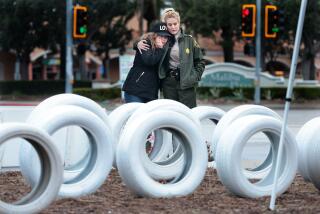La Canada Flintridge Speed-Limit Survey Out of Date : Youth Eludes Fine After Pothole Found in Law
It all started with a youth who got a speeding ticket.
The teen-ager’s enterprising attorney, looking for a way to avert his client’s paying the ticket, discovered a relatively obscure state law. By the time the attorney was through, not only was his client’s ticket dismissed, but the city of La Canada Flintridge found its system for enforcing speed limits in shambles.
According to state law, to enforce speed limits by radar, cities must have a current and valid traffic and engineering survey determining speed limits for city streets. The surveys are valid for five years, and La Canada’s last survey was completed Jan. 26, 1984.
The attorney contested the validity of the city’s speed limits on the basis of that law, arguing that a current traffic and engineering survey must be on file with the court.
The juvenile traffic court in Pasadena dismissed the ticket, and a referee from the court sent a memo to the Sheriff’s Department warning that other tickets would be dismissed if issued by La Canada Flintridge and other area cities whose surveys had expired or were not filed with the court.
“An officer is considered incompetent by law to testify as a witness in a radar case,” Marcia Luecke, a referee with the juvenile traffic court in Pasadena, said in a telephone interview. “I will not sustain a ticket unless there is a valid and current survey.”
According to state law, if an officer uses radar or other electronic equipment to determine a driver’s speed, he may not testify based on his estimation of the driver’s speed after the fact.
When the Sheriff’s Department forwarded Luecke’s memo to the city during the first week of March, the City Council hurriedly hired a consultant to complete a new survey and was obliged to pass an emergency ordinance at the next council meeting.
According to City Manager Don Otterman, the court and the city were interpreting the state law differently. The court read the law as saying a survey expires five years after the study is completed.
“We interpreted it as the time the survey was adopted,” Otterman said. “The survey and ordinance were put together and went through first and second reading in City Council. By the time it actually went into effect, it was May” of 1984, he said.
The ordinance was not just an exercise in bureaucratic imperative. As a result of the survey, the city will increase the speed limit on three residential streets, decrease the limit on two and establish a new limit on two streets that had no existing posted limit.
An increased speed limit for areas of Gould Avenue, Greenridge Drive and Highland Avenue was recommended by the traffic engineer on the basis of a number of considerations, including the speed at which people are actually driving.
“The courts have held that the speed at which 85% of the people drive is a reasonable and prudent speed limit,” said Fullmer Chapman, director of public works. “If speed limits are below that, you’re setting a speed trap.”
More to Read
Sign up for Essential California
The most important California stories and recommendations in your inbox every morning.
You may occasionally receive promotional content from the Los Angeles Times.










